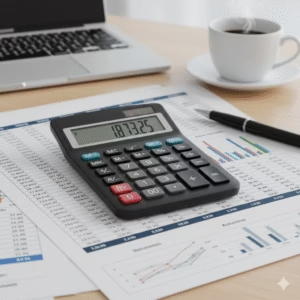How to do a year-end financial check-up
Learn how to check your finances before the New Year

The end of the year is a time of reflection, celebration, and—let’s be honest—a lot of spending. But as the holiday lights dim and we look toward January, there’s a natural urge for a “fresh start.” We set new goals, buy new gym memberships, and promise that this will be the year we get our lives in order.
But what about your financial life?
Most of us would rather brave the holiday crowds at the mall than look at 12 months’ worth of bank statements. We treat our finances like a mystery, hoping for the best. But hope is not a strategy.
Think of it like your annual physical. You go to the doctor not because you’re necessarily sick, but to get a baseline—to check your vitals, see what’s working, and catch potential problems before they become serious. A year-end financial check-up is the exact same thing. It’s a non-judgmental, data-driven look at your “financial health.”
This guide is your simple, step-by-step checklist. We’re not here to judge you for that expensive vacation or the over-budget holiday gifts. We’re here to give you a clear picture of your starting line so you can make 2026 your wealthiest year yet.
Why a Year-End Financial ‘Health’ Check Is Non-Negotiable

Before we dive in, let’s get one thing straight: This is a no-shame zone.
The only goal of this check-up is to gather data. You cannot plan a road trip without knowing your current location. You cannot build a financial future without knowing your starting point.
Looking back at your 2025 spending isn’t about feeling guilty. It’s about finding patterns. It’s about trading unconscious spending for conscious choices. You might discover you spent $2,000 on subscriptions you don’t use, or that your “small” daily coffee habit added up to $1,500. That’s not a “failure”; that’s $1,500 in found money that you can now redirect to your goals in 2026.
This 10-step check-up will empower you by replacing anxiety with a concrete plan.
1. Calculate Your Net Worth (Your Financial ‘Scoreboard’)
If you only track one number in your financial life, make it this one. Your net worth is the single best measure of your financial health. It’s your personal “scoreboard.”
The formula is simple:
What You OWN (Assets) – What You OWE (Liabilities) = Your Net Worth
How to Do It:
Grab a piece of paper or open a spreadsheet. Make two columns.
- ASSETS (What you OWN):
- Cash (Checking, Savings, Emergency Fund)
- Retirement Accounts (401(k), IRA, Roth IRA balances)
- Taxable Investment Accounts (Brokerage accounts)
- Home Equity (Estimated market value of your home minus what you owe on the mortgage)
- Other Valuables (Cars, jewelry, etc. – be conservative here)
- LIABILITIES (What you OWE):
- Credit Card Balances
- Student Loan Balances
- Mortgage Balance
- Auto Loan Balances
- Personal Loans
Subtract your total liabilities from your total assets. The result is your net worth. It might be positive, it might be negative. It does not matter. This is just your starting number for January 1st. Your only goal for 2026 is to make this number go up.
2. How to Review Your 12-Month Cash Flow (Without Judgment)

This is the “financial autopsy” of 2025. It answers the one question that haunts us all: “Where did my money go?”
You don’t need to track every penny. You’re looking for the “big leaks.”
- How to Do It: Use a budgeting app (like YNAB, Mint, or Monarch Money) that can import your transactions. Or, simply download your last 12 months of credit card and bank statements.
- Look for the Big 3 “Leaks”:
- Subscriptions & Memberships: Tally up every recurring charge (streaming services, gym memberships you don’t use, software, apps). Are you still using them all?
- Food (The Big One): Add up “Groceries” vs. “Restaurants/Takeout/Food Delivery.” This number is often the most shocking and the easiest to improve.
- “Lifestyle Creep”: Did you get a raise this year? Did your savings rate go up, or did your spending on “wants” (shopping, travel, hobbies) simply expand to meet your new income?
Find your top 3-5 spending categories. This is where you’ll focus your 2026 budget.
3. Assess Your Debt-to-Income Ratio and Create a Payoff Plan
Debt is a weight. High-interest debt, like credit cards, is a 50-pound weight that’s actively pulling you underwater. This step is about checking that weight and making a plan to cut it loose.
- Find Your “Bad” Debt: List all your debts, their balances, and their interest rates (APR). Pay special attention to anything with an APR over 8-10% (especially credit cards).
- Choose Your 2026 Payoff Plan:
- The Debt Avalanche (Best for Math): List your debts from highest APR to lowest. Make minimum payments on everything, but throw every extra dollar you have at the highest-APR debt first. This saves you the most money in interest.
- The Debt Snowball (Best for Motivation): List your debts from smallest balance to largest. Make minimum payments on everything, but throw every extra dollar at the smallest balance first. When it’s paid off, you get a quick psychological win and “roll” that payment onto the next-smallest debt.
Both work. Pick the one you’ll stick with.
4. Check Your Credit Score and Pull Your Free Annual Report
Your credit score is your “financial report card.” It dictates the interest rate you’ll get on a mortgage, an auto loan, or a credit card. A good score can save you tens of thousands of dollars over your lifetime.
- Check Your Score: You can often get this for free from your credit card provider or bank.
- Pull Your Report (The Most Important Part): Go to
AnnualCreditReport.com. This is the only official, free site mandated by the U.S. government. You are entitled to one free report from each of the three bureaus (Equifax, Experian, TransUnion) every year. - What to Look For:
- Errors: Is there a debt listed that isn’t yours? An account you don’t recognize? Dispute it immediately.
- Payment History: Make sure all your on-time payments are reported correctly.
- Credit Utilization: This is the ratio of your credit card balance to your credit limit. Pro-Tip: For the best score, keep this below 30% (and ideally below 10%). If your limit is $10,000, try to keep your balance below $3,000.
5. What Does Rebalancing Your Investment Portfolio Mean?

This is a key part of your investment check-up. Think of your portfolio as a recipe. Maybe your original recipe was 60% stocks (for growth) and 40% bonds (for stability).
- The Problem: “Portfolio Drift”Let’s say in 2025, stocks had a fantastic year, and bonds were flat. Your 60% in stocks might have grown so much that it’s now 70% of your total portfolio. Your “moderate” 60/40 recipe has “drifted” into a more aggressive 70/30 recipe, and you’re now taking on more risk than you intended.
- The Solution: “Rebalancing”Rebalancing is simply restoring your original recipe. You would sell 10% of your (now-overweight) stocks and use the money to buy 10% more bonds.
- Why It’s Smart: This forces you to obey the #1 rule of investing: “Buy low, sell high.” You are automatically selling what has done well (selling high) and buying what has underperformed (buying low).
- How to Do It: Most 401(k) and IRA platforms have a “rebalance” button. In a taxable account, be careful of taxes (see next step).
6. How Tax-Loss Harvesting Can Reduce Your 2026 Tax Bill
This is an “advanced” but powerful strategy to use in your taxable brokerage account (this does not apply to your 401(k) or IRA).
- The Concept: If you’re rebalancing (see Step 5) and need to sell some “winners” that will trigger a capital gains tax, you can offset that tax.
- How it Works: Look for any “losers” in your portfolio—stocks or funds that are worth less than you paid for them.
- The Action: You can sell those “losers” and “harvest” the loss. This capital loss can be used to cancel out your capital gains.
- Example: You sell Stock A for a $5,000 gain. You sell Stock B for a $4,000 loss. You now only pay taxes on a $1,000 gain.
- Even Better: If your losses are greater than your gains, you can use up to $3,000 of that net loss to reduce your regular taxable income from your job.
- The Big Warning (Wash Sale Rule): You cannot sell a stock for a loss and buy it (or a “substantially identical” one) back within 30 days.
7. The Critical Year-End Retirement Account Check-In
Your retirement accounts are your most powerful wealth-building tools. The end of the year is the perfect time to give them a tune-up.
- Are you getting the FULL 401(k) match?If your employer offers a 401(k) match (e.g., “50% match on the first 6% you contribute”), you must contribute at least 6% to get that match. Not doing so is literally throwing away free money (a 50% guaranteed return).
- Can you “max out” your 2025 contributions?You have until the tax deadline in April 2026 to max out your 2025 IRA contributions. For your 401(k), your deadline is December 31. If you have a year-end bonus, consider using it to hit these limits.
- Plan your 2026 contributions.The IRS usually announces new (higher) contribution limits for the next year in the fall. Log into your 401(k) platform now and set your 2026 contribution percentage. Aim to increase it by at least 1%.
8. How to Conduct an Annual Insurance Policy Review (Your ‘Defense’)

Your financial plan has an offense (investing) and a defense (insurance). Your defense protects you from a single bad event (a car crash, a fire, an illness) wiping out all your progress.
- Auto Insurance: “Loyalty” is often punished. Get new quotes every year. Premiums can creep up. Also, review your deductible. If you now have a healthy emergency fund, you might raise your deductible (e.g., from $500 to $1,000) and save hundreds on your premium.
- Homeowners/Renters Insurance: Due to inflation, the cost to rebuild your home or replace your stuff is much higher than it was a few years ago. Is your coverage still enough? Pro-Tip: Walk through your house with your smartphone and take a video of everything you own. Store it in the cloud. This “video inventory” is priceless if you ever need to make a claim.
- Life Insurance: Do you have it? If anyone (a spouse, a child) depends on your income, you need term life insurance. It’s remarkably cheap. If you already have it, is it enough?
- Disability Insurance: This is the most overlooked. Your single greatest asset is your ability to earn an income. Disability insurance protects that paycheck. Check if your employer offers it, and consider supplementing it.
9. Why You Must Check and Update Your Beneficiaries
This is the 5-minute task that can save your family from a legal and financial nightmare.
- What It Is: A beneficiary is the person who will inherit your accounts directly, bypassing your will and the costly probate court system.
- Where to Check:
- Your 401(k) and IRA
- Your Life Insurance policies
- Your brokerage accounts
- Sometimes even your bank accounts
- The Horror Story: The most common tragedy is finding that an ex-spouse is still listed as the beneficiary on a 401(k) from an old job. After a death, that ex-spouse will get the money, even if your will says otherwise. Fix this. Now.
10. Set SMART Financial Goals for the New Year
Your check-up is complete. You have your data. Now, what are you going to do with it? This is where you set your 2026 plan. Don’t use vague wishes; use SMART goals.
- Specific: What exactly do you want to do?
- Measurable: How will you track it?
- Achievable: Is it realistic?
- Relevant: Why does this matter to you?
- Time-bound: By when?
Vague Wish: “I want to save more money.”
SMART Goal: “I will build a $3,000 starter emergency fund (S) in a new High-Yield Savings Account (M). I will do this by setting up an automatic transfer of $250 on the 1st of every month (A). This will give me one month of expenses as a buffer against debt (R). I will reach this goal by December 31, 2026 (T).”
Your Fresh Start Begins Now

A financial check-up might sound intimidating, but it’s the single most empowering thing you can do for your money.
You don’t have to do all 10 steps in one day. Start with Step 1. Calculate your net worth. Tomorrow, pull your credit report. This weekend, review your insurance.
By breaking it down, you are trading anxiety for action. You are moving from being a passive passenger in your financial life to being the pilot. The “fresh start” you want for the new year doesn’t begin on January 1st—it begins today, with this plan.





